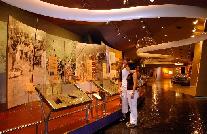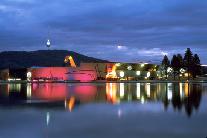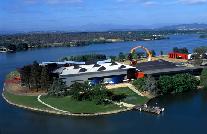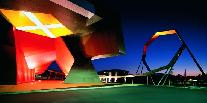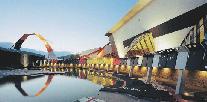OCEANIA
National Museum of Australia (Australia)
(Sept. 8, 2010)
by National Museum of Australia Publicist
The National Museum of Australia is devoted to the preservation and interpretation of Australia’s social history, exploring the key issues, people and events that have shaped the nation and the land over thousands of years. Bringing together the rich and diverse stories of Australia and its people, the National Museum has an international reputation for innovative exhibitions and events.
The National Museum of Australia opened on 11 March 2001 to coincide with Australia's Centenary of Federation. Although one of Australia's newest cultural institutions, it has been almost 100 years in the making. Over the course of the twentieth century, proposals for a national museum were intermittent, interrupted by wars and financial crises and stifled by government inaction.
A national inquiry in 1975 finally resulted in the Museum's birth in 1980 with the passing of National Museum of Australia Act.
In December 1996 the announcement was made that the Museum would be built as the key Centenary of Federation project and Acton Peninsula was chosen as the site. In 1997 funding was approved and an international design competition launched for the building of the Museum.
The National Museum is home to the National Historical Collection — more than 200,000 historical and Indigenous objects collected since 1980.
The National Museum of Australia is a museum of social history. Its exhibitions, collections, programs and research focus on three interrelated themes:
*Aboriginal and Torres Strait Islander history and culture
*Australia's history and society since 1788
*The interaction of people with the environment
Five permanent galleries and a range of temporary exhibitions profile 50,000 years of Indigenous heritage, settlement since 1788 and key events including Federation and the 2000 Sydney Olympic Games.
The Museum's National Historical Collection includes the world's largest collection of Aboriginal bark paintings, the heart of Australian racehorse Phar Lap and the Holden prototype no.1 car.
The Museum's exhibitions and collections are underpinned by world class research. National Museum of Australia Press publishes a wide range of books, catalogues and journals and the Centre for Historical Research, through its cross-disciplinary approach to history, ensures the Museum is an even livelier forum for ideas and debate about the past, present and future.
The National Museum also develops travelling exhibitions on subjects ranging from bushrangers to surf lifesaving to reach out to visitors across Australia.
Excitement and innovation are not just limited to the exhibits. The striking building is an architectural landmark which complements the beautiful surroundings of Canberra's Acton Peninsula. The jigsaw-like building wraps around the central Garden of Australian Dreams, a symbolic landscape and remarkable cultural arena.
The building reflects the many intertwined stories that make up Australia's history. One of these tangled threads of history is the dramatic loop which rises 30 metres above the Museum entrance.
Address: GPO Box 1901, Canberra ACT 2601
Phone: +61 2 6208 5000
Homepage: www.nma.gov.au
Days closed: Christmas Day
Admission: Free
(Originally published on September 6, 2010)
 Peace Museums of OCEANIA
Peace Museums of OCEANIA
